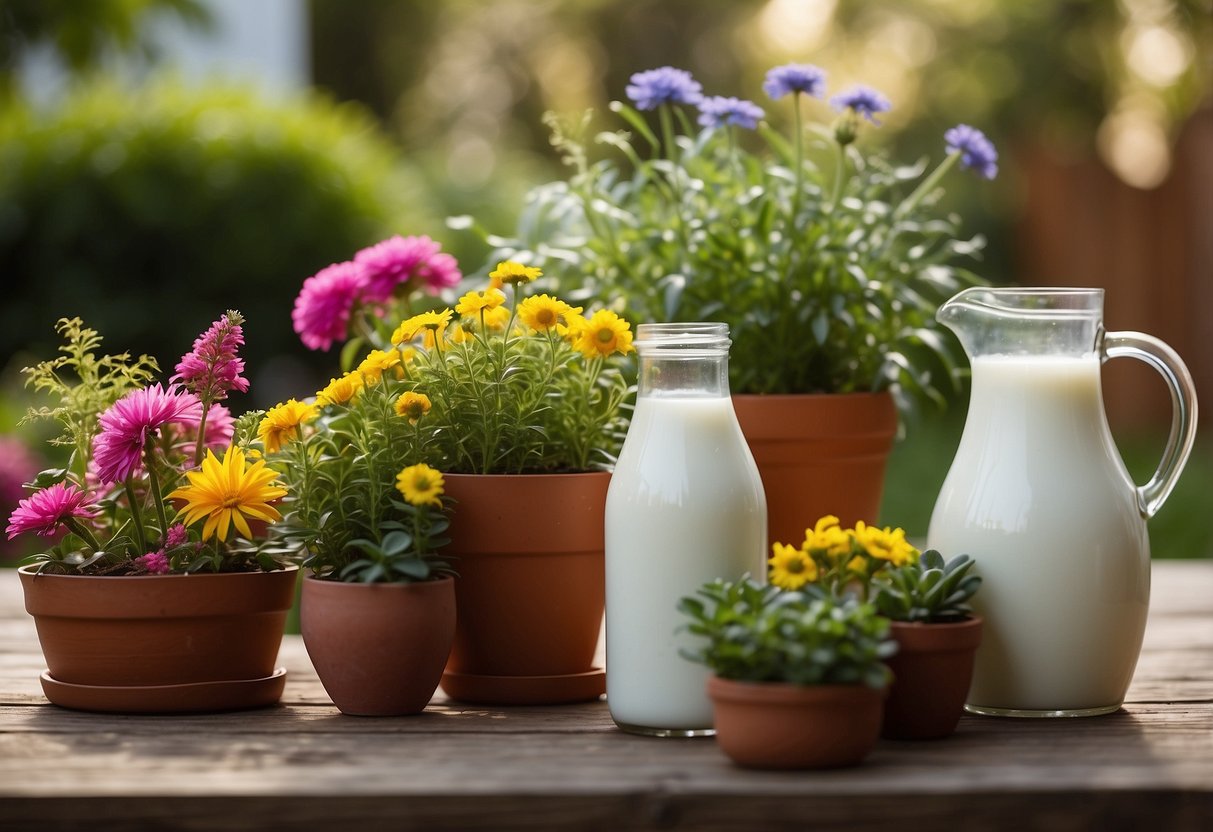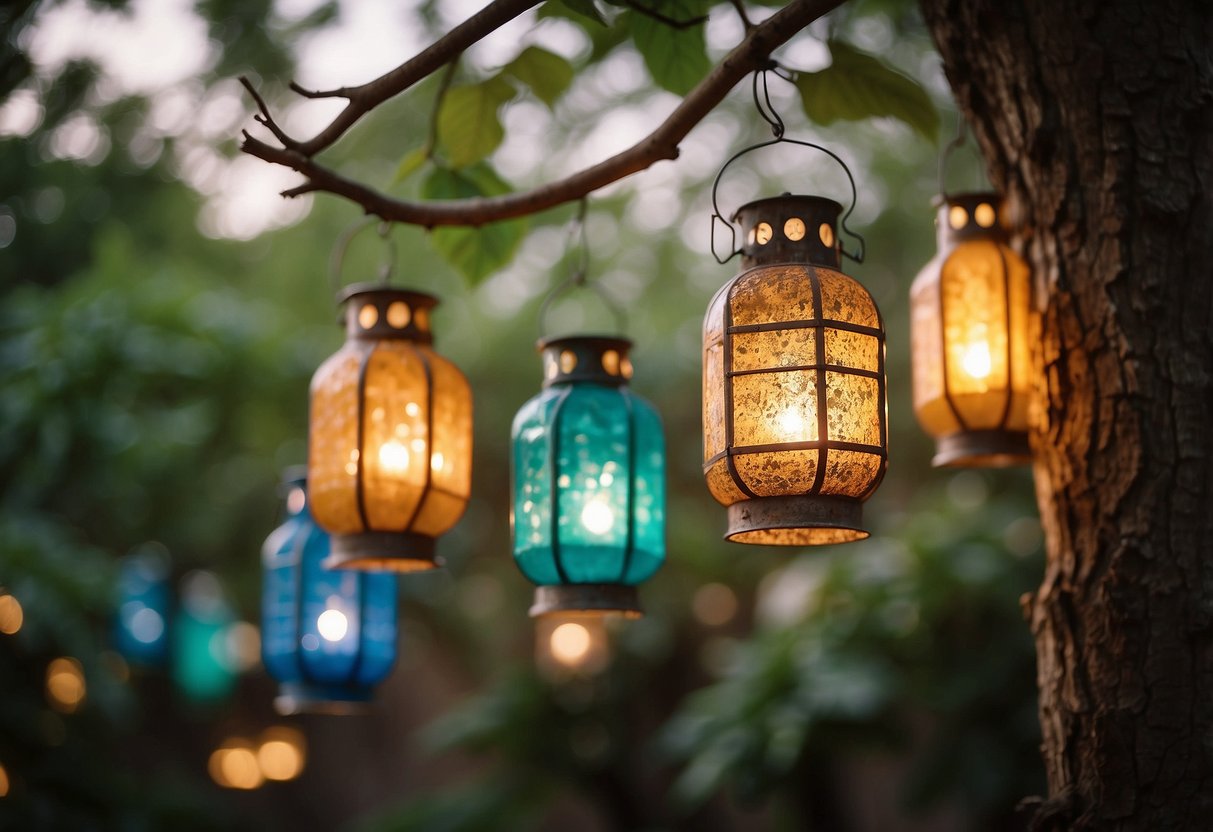Milk Jug Garden Ideas: Creative and Fun Ways to Recycle
Using milk jugs in your garden is a fantastic way to recycle and get creative with your gardening techniques. These simple plastic containers can serve multiple purposes, helping you save money and reduce waste in the process. Why throw away your old milk jugs when they can be transformed into helpful tools for your garden?

You’ll be amazed at how many ways you can repurpose a basic milk jug to benefit your plants. From watering systems to planters, the possibilities are endless and easy to implement. Ready to give your garden a boost without breaking the bank? Keep reading to discover innovative and practical milk jug garden ideas.
1) Herb Planters

Turn your empty milk jugs into handy herb planters. Cut off the top half of the jug and poke some drainage holes in the bottom. Fill it with soil and plant your favorite herbs like basil, mint, or parsley.
Label the outside with the herb’s name. This way, you always know what’s growing. Try placing these planters on a sunny windowsill or your balcony. If you need more ideas, check out these creative ways to use milk jugs in the garden.
2) Bird Feeders

Creating bird feeders from milk jugs is a fun and eco-friendly project.
First, clean the jug thoroughly. Cut large, rectangular holes on two sides of the jug for the birds to access the seeds. Make sure the edges are smooth to prevent any harm to the birds.
Next, poke a few small holes at the bottom for rain drainage.
Use a strong wire or twine to hang it from a tree branch.
Decorate the outside with paint or stickers to make it visually appealing. This is a great way to recycle and enjoy bird watching in your garden.
For more ideas, visit 17 DIY Milk Jug Bird Feeder or 13 Ways to Build a Bird Feeder from Milk Jug.
3) Watering Cans

Using an old milk jug as a watering can is both easy and eco-friendly. You just need to cut off the top of the milk jug and poke holes in the cap. Fill it with water, and you’re ready to water your plants.
This DIY trick works great for small gardens or houseplants. The handle of the jug makes it easy to carry and pour. You can even make a sprinkler lid for a gentle water flow. This way, you reduce waste and keep your plants happy.
4) Garden Lanterns

Transform your garden with milk jug lanterns. Start by cutting out a small hole in the bottom of the jug. Insert string lights through the hole.
The cloudy plastic creates a soft, inviting glow. Hang them on trees or place them along pathways. These lanterns make your garden feel cozy and magical, perfect for evening gatherings.
For more ideas on creating garden lanterns, check out these creative milk jug lanterns.
5) Hanging Planters

Using milk jugs as hanging planters is a great way to repurpose plastic. It’s simple and effective.
Cut the top off a clean milk jug and punch holes in the bottom for drainage. Thread strong string through holes on each side, creating sturdy handles.
Fill the jug with soil and plant herbs, flowers, or strawberries. Hang your new planter from a porch or tree branch. Creating these hanging planters is easy and adds greenery to small spaces.
For more ideas, check out this article on DIY milk jug projects.
6) Fairy Gardens

With a milk jug, you can create a charming fairy garden. Simply cut the jug in half and fill it with soil. Use tiny plants like succulents or moss, which need little maintenance.
Add miniature accessories such as a small house, tiny furniture, and even fairy figures. These details make your fairy garden come alive. Consider using items like grapevine balls to add a natural touch. For more ideas, check out these fairy garden tricks.
Fairy lights can give it a magical glow at night. It’s a perfect, whimsical addition to your backyard.
7) Tool Storage

You can use a milk jug to store small garden tools. Cut off the top part of the jug to create an open container. This way, you can easily place tools inside and carry them around the garden.
Another idea is to poke holes in the sides to hang it on hooks. This keeps your tools organized and ready to use.
A milk jug is sturdy enough to hold items like gloves, trowels, and pruners, making your gardening tasks easier.
8) Compost Scoopers

You can turn an old milk jug into a handy compost scooper. Cut the base off at a diagonal angle. This creates a scoop with a handle, making it easy to get a good grip.
With the lid on, it scoops compost without spilling. Take the lid off, and it can also be used as a funnel for other gardening needs.
Using these scoops can save you money and reduce waste in your garden.
9) Seedling Starters

You can use milk jugs to start your seedlings early. Simply cut the jug in half, keeping the handle intact to act as a hinge. Add drainage holes at the bottom and fill it with seed starter mix.
After planting your seeds, water the mix lightly. Seal the jug with duct tape and label it with a marker. Your seedlings will have a cozy home to grow in!
10) Succulent Planters

You can turn empty milk jugs into super cute succulent planters. Just cut the top off the jug, giving you enough space to fit your plants. Make sure to poke some drainage holes in the bottom to keep your succulents happy.
Next, fill the jug with soil and plant your succulents. You can even decorate the outside for extra flair. This is a fun, easy way to recycle and beautify your garden! For more ideas on upcycling, check out these creative succulent planter ideas.
Starting Your Milk Jug Garden

Starting a milk jug garden is a wonderful way to get your seeds growing early. This section will help you select the best containers and prepare the perfect soil mix.
Choosing the Right Containers
You need clean, empty milk jugs to get started. Plastic milk jugs work best because they are easy to cut and manipulate. Make sure to wash them thoroughly to remove any milk residue.
Cut the jugs in half but leave a small section near the handle to act as a hinge. This will allow you to open and close the top easily. Drill several small drainage holes in the bottom to ensure surplus water can escape. About 10-12 holes, spaced evenly, should be enough.
You can often find used milk jugs at recycling centers or ask friends and neighbors for their empties. Label each jug with the type of seed and date of planting using a waterproof marker.
Preparing the Soil Mix
For the soil mix, use a combination of potting soil and compost. The potting soil provides essential nutrients while the compost improves soil structure and moisture retention. Fill each milk jug with about three inches of this mix.
It’s important to moisten the soil before planting seeds. Lightly water the soil until it’s damp but not waterlogged. Use a gentle spray, like from a watering can or pump sprayer, to avoid washing away any seeds.
After filling the jug and moistening the soil, plant your seeds according to their specific depth requirements. Check the seed package for guidance. Cover the seeds lightly with more soil and gently pat it down.
Planting Ideas for Milk Jug Gardens

Milk jug gardens provide a versatile and easy way to start your gardening journey. You can grow a range of vegetables, herbs, and flowers using these simple greenhouses. Below, you’ll find some great planting ideas to get the most out of your milk jug garden.
Vegetable and Herb Options
Vegetables and herbs are fantastic choices for milk jug gardens. They grow well in the controlled environment provided by the jugs. Lettuce and spinach are great leafy greens to start with because they germinate quickly and don’t need much space. Radishes and carrots are also excellent options: they grow well in deep containers if you cut the milk jugs accordingly.
For herbs, try planting basil or parsley. These herbs grow quickly and can be snipped as needed for cooking. Cilantro and chives are also good choices, offering fresh flavors for your dishes.
Consider using a light, well-draining potting mix and keep the soil moist but not waterlogged. Here’s a simple table of vegetables and herbs suitable for milk jug gardens:
| Vegetables | Herbs |
|---|---|
| Lettuce | Basil |
| Spinach | Parsley |
| Radishes | Cilantro |
| Carrots | Chives |
Flower Varieties that Thrive
Flowers can add beauty to your milk jug garden. Marigolds are a great choice because they are hardy and can handle various growing conditions. Petunias are another flower that thrives in the enclosed space of a milk jug, providing colorful blooms with minimal care.
Zinnias are also a good option. They grow quickly and can bloom throughout the season with regular watering. Nasturtiums are beneficial for your garden as they attract pollinators and repel some pests.
Use a good quality soil mix, keep the jugs in a sunny location, and ensure proper drainage by drilling sufficient holes in the bottom. Here are some flowers that do well in milk jug gardens:
- Marigolds
- Petunias
- Zinnias
- Nasturtiums
Maintaining Your Milk Jug Garden

To keep your milk jug garden thriving, it’s essential to focus on proper watering routines and pest control methods. Ensuring these elements will help your plants grow healthily and produce better yields.
Watering Tips and Schedules
Watering your milk jug garden effectively ensures that your plants receive the right amount of moisture. Milk jugs with drainage holes are good at preventing waterlogging.
For most plants, watering every 2-3 days is sufficient, but this can vary based on the plant type and weather. In hot weather, you might need to water daily. Use a watering can or a hose with a gentle spray to avoid damaging seedlings.
Checking the soil moisture regularly with your fingers is helpful. If it’s dry about an inch below the surface, it’s time to water. Be mindful of the early morning or late evening timings to minimize water evaporation.
Dealing with Pests
Protecting your plants from pests is crucial for a healthy garden. Milk jugs can be used to create simple barriers against insects. Cutting the top off a milk jug and placing it around seedlings can shield them from pests like aphids and slugs.
You can also make a homemade insect spray using soap and water. Mix a teaspoon of mild dish soap with a liter of water in a spray bottle. Spray this solution on plants infested with aphids or other soft-bodied insects. Regularly inspect your garden for signs of pest damage, such as holes in leaves or discolored foliage.
Promoting natural predators like ladybugs and spiders in your garden can help manage pest populations. They can be attracted by planting flowers or using purchased insect habitats. Sharing space with other plants that repel pests, such as marigolds or garlic, can also be beneficial.







